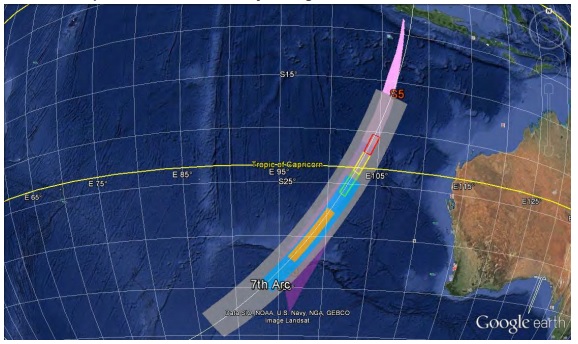Australia, Malaysia, and China have established the priority search area for MH370, the Malaysia Airlines Boeing 777-200ER aircraft that disappeared on 8 March.
The revised undersea search area is south of where an aerial and accoustic search took place in March and April, but is still along the “seventh arc”, where the aircraft transmitted its final communication, says Australian Minister for Infrastructure and Regional Development Warren Truss.
The total area is 60,000 square kilimoters, and it is expected to take 12 months to search it throughly. This element of the search will commence in August, following a bathymetric (seafloor mapping) survey that is now underway.
“The new priority area is still focused on the seventh arc, where the aircraft last communicated with satellite,” says Truss. “We are now shifting our attention to an area further south along the arc based on these calculations.”
Underwater search areas: wide (grey), medium (blue), and priority (orange)

ATSB
He adds that Malaysia and Australia will sign a memorandum of undestadning to determine the areas of cooperation related to the search, including recovery activities and financial details. Malaysia will also shortly announce details of assets contracted to search the priority zone.
Truss’s statement is accompanied by a 64-page Australian Transport Safety Bureau (ATSB) report that details the MH370 incident from the moment the aircraft disappeared, and the justification for moving the search farther south.
The report shows that the priority search area extends along the arc for 650km in a northeast direction from the “broken ridge” geographic feature tha runs in a south-easterly direction across the seventh arc. This area was the subject of a surface search about a month after the aircraft’s disappearance.
“The ATSB defined underwater search areas using an aggregate of the results from five independent analyses,” says the report. “Individual solutions had provided either a preferred flight path or a range of candidate flight paths spanning a length along the seventh arc. The results showed a high degree of correlation between the preferred paths and the high ranking candidate paths.
“The search strategy working group combined this analysis with the location of the 7th arc and width analysis to derive three search areas. These three search areas were designated wide, medium and priority.”
It adds that work continues to identify the best search areas within the priority zone, and that areas beyond the priority zone could be search should assets become available.
Source: Cirium Dashboard























